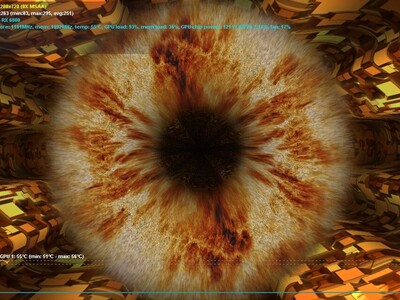- Amlogic S905, S912 processzoros készülékek
- Milyen belső merevlemezt vegyek?
- Melyik tápegységet vegyem?
- AMD GPU-k jövője - amit tudni vélünk
- A régi node-okra koncentrál a szankciók miatt Kína
- LG LCD és LED TV-k
- Asztrofotózás
- AMD K6-III, és minden ami RETRO - Oldschool tuning
- OLED TV topic
- Gaming notebook topik
Hirdetés
-


AMD Radeon undervolt/overclock
lo Minden egy hideg, téli estén kezdődött, mikor rájöttem, hogy már kicsit kevés az RTX2060...
-


Rossz üzlet az EV-kölcsönzés
it Küszködik az EV-kölcsönzés miatt a Hertz Global, még több EV-t adnak el.
-


Free Play Days 2024 - 17. hét: Railway Empire, Prison Architect
gp Extraként a TramSim: Console Edition című játékot is kipróbálhatják az érdeklődők.
-

PROHARDVER!
Téma összefoglalónk újra és újra megújul, reméljük, elnyeri mindenki tetszését és segít a könnyebb tájékozódásban !
 Az alábbiakban DSLR (digitális tükörreflexes) és MILC (tükör nélküli cserélhető objektíves) fényképezőgépek vásárlásában szeretnénk tanácsot adni, figyelembe véve az aktuális piaci trendeket, felhasználói szokásokat és technológiai újításokat.
Az alábbiakban DSLR (digitális tükörreflexes) és MILC (tükör nélküli cserélhető objektíves) fényképezőgépek vásárlásában szeretnénk tanácsot adni, figyelembe véve az aktuális piaci trendeket, felhasználói szokásokat és technológiai újításokat.
Új hozzászólás Aktív témák
-

silmatauki
őstag
válasz
 Colonel993
#23628
üzenetére
Colonel993
#23628
üzenetére
Sokat hasonlítgattam a D5300/3300-as videók moiréját / aliasingját a Canonokéhoz & Fujikéhoz. Mind a Canon consumer crop vázai, mind az összes Fuji összehasonlíthatatlanul rosszabbak moiré / aliasing-téren. Persze felbontásban, ahogy a cikk is írja, nem éri el a legjobb consumer cuccokat (pl. GH-sorozat). De ha nem hisztek nekem, itt egy review: http://www.eoshd.com/2014/02/nikon-d5300-review/ (kiemelés tőlem):
"Neither can quite match the GH3 for detail in 1080p (let alone the GH4). I believe the trick Panasonic are using to give us such crisp 1080p on their cameras is to down-sample the sensor to roughly 2.5K and then oversample 1080p from that higher resolution raw image. The D5300 looks like the 5D Mark III’s stock video mode for resolution – it’s a bit mushy. You notice this the most when shooting in daylight at focus points between infinity and roughly 5 meters. Sometimes you don’t notice the softness much at all, so it’s not the camera’s main problem.
With sharpness dialled down in-camera it will look very soft and require digital sharpening to be added in post. You can do this in-camera by simply leaving it on the Standard or Vivid picture profile and not turning down sharpness. Whatever method you use the results after grading look similar.
Compared to the Canon Rebels, 6D and 70D the Nikon D5300 has far lower moire & aliasing (it’s almost unnoticeable) in videos and better low light performance than the Canon APS-C fleet. Stills are also way ahead now on the Nikon cameras compared to the Rebels. With a near-2 stop dynamic range advantage and a significant resolution bump over Canon, the Toshiba sensor in the D5300 rates over 20 points higher than Canon’s 700D on the DXOMark chart, and 15 higher than the 70D. JPEGs and raw stills out of the D5300 are very good indeed."
[ Szerkesztve ]
Új hozzászólás Aktív témák
- Cyberpunk 2077
- Motorola Moto G24 Power - hol van az erő?
- Hálózati / IP kamera
- Amlogic S905, S912 processzoros készülékek
- Sub-ZeRo: Euro Truck Simulator 2 & American Truck Simulator 1 (esetleg 2 majd, ha lesz) :)
- Milyen belső merevlemezt vegyek?
- Yettel topik
- Melyik tápegységet vegyem?
- Luck Dragon: Asszociációs játék. :)
- PlayStation 4
- További aktív témák...







 Az alábbiakban DSLR (digitális tükörreflexes) és MILC (tükör nélküli cserélhető objektíves) fényképezőgépek vásárlásában szeretnénk tanácsot adni, figyelembe véve az aktuális piaci trendeket, felhasználói szokásokat és technológiai újításokat.
Az alábbiakban DSLR (digitális tükörreflexes) és MILC (tükör nélküli cserélhető objektíves) fényképezőgépek vásárlásában szeretnénk tanácsot adni, figyelembe véve az aktuális piaci trendeket, felhasználói szokásokat és technológiai újításokat.

 Mr.Csizmás
Mr.Csizmás